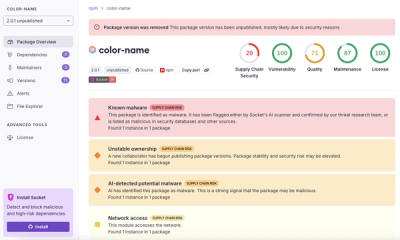
Research
/Security News
npm Author Qix Compromised via Phishing Email in Major Supply Chain Attack
npm author Qix’s account was compromised, with malicious versions of popular packages like chalk-template, color-convert, and strip-ansi published.
@bun-community/sveltekit-adapter-bun
Advanced tools
Adapter for SvelteKit apps that generates a standalone Bun.js server.
Adapter for SvelteKit apps that generates a standalone Bun server.
Warning This is experimental module! Bun does not support many things like
FormDataSo I can't promise it will work
Install with bun add -d @bun-community/sveltekit-adapter-bun or npm i -D @bun-community/sveltekit-adapter-bun, then add the adapter to your svelte.config.js:
// svelte.config.js
import adapter from '@bun-community/sveltekit-adapter-bun';
export default {
kit: {
adapter: adapter()
}
};
After building the server (vite build), use the following command to start:
# go to build directory
cd build/
# run Bun
bun run start
You can use buns websocket server by exporting handleWebsocket object from src/hooks.server.ts
export const handleWebsocket = {
message: (ws, msg) => {
ws.send(msg);
},
//optionally, doesnt have to be set - can be used to deny websocket
upgrade: (req, upgrade) => {
upgrade(req, {data:1});
}
}
The adapter can be configured with various options:
// svelte.config.js
import adapter from '@bun-community/sveltekit-adapter-bun';
export default {
kit: {
adapter: adapter({
out: "build",
assets: true,
envPrefix: "MY_CUSTOM_",
development: true,
// precompress: true,
precompress: {
brotli: true,
gzip: true,
files: ["htm", "html"]
},
dynamic_origin: true,
xff_depth: 1
})
}
};
The directory to build the server to. It defaults to build — i.e. bun run start would start the server locally after it has been created.
Browse a static assets. Default: true
Enables precompressing using gzip and brotli for assets and prerendered pages. It defaults to false.
Enable brotli precompressing. It defaults to false.
Enable gzip precompressing. It defaults to false.
file extensions to compress.It defaults to ['html','js','json','css','svg','xml','wasm'].
If you need to change the name of the environment variables used to configure the deployment (for example, to deconflict with environment variables you don't control), you can specify a prefix:
envPrefix: 'MY_CUSTOM_';
MY_CUSTOM_HOST=127.0.0.1 \
MY_CUSTOM_PORT=4000 \
MY_CUSTOM_ORIGIN=https://my.site \
bun build/index.js
This enables bun's error page. Default: false
If enabled use PROTOCOL_HEADER HOST_HEADER like origin. Default: false
The default value of XFF_DEPTH if environment is not set. Default: 1
Bun automatically reads configuration from
.env.local,.env.developmentand.env
PORT and HOSTBy default, the server will accept connections on 0.0.0.0 using port 3000. These can be customized with the PORT and HOST environment variables:
HOST=127.0.0.1 PORT=4000 bun build/index.js
ORIGIN, PROTOCOL_HEADER and HOST_HEADERHTTP doesn't give SvelteKit a reliable way to know the URL that is currently being requested. The simplest way to tell SvelteKit where the app is being served is to set the ORIGIN environment variable:
ORIGIN=https://my.site bun build/index.js
With this, a request for the /stuff pathname will correctly resolve to https://my.site/stuff. Alternatively, you can specify headers that tell SvelteKit about the request protocol and host, from which it can construct the origin URL:
PROTOCOL_HEADER=x-forwarded-proto HOST_HEADER=x-forwarded-host bun build/index.js
x-forwarded-protoandx-forwarded-hostare de facto standard headers that forward the original protocol and host if you're using a reverse proxy (think load balancers and CDNs). You should only set these variables if your server is behind a trusted reverse proxy; otherwise, it'd be possible for clients to spoof these headers.
ADDRESS_HEADER and XFF_DEPTHThe RequestEvent object passed to hooks and endpoints includes an event.clientAddress property representing the client's IP address. Bun.js haven't got functionality to get client's IP address, so SvelteKit will receive 127.0.0.1 or if your server is behind one or more proxies (such as a load balancer), you can get an IP address from headers, so we need to specify an ADDRESS_HEADER to read the address from:
ADDRESS_HEADER=True-Client-IP bun build/index.js
Headers can easily be spoofed. As with
PROTOCOL_HEADERandHOST_HEADER, you should know what you're doing before setting these. If theADDRESS_HEADERisX-Forwarded-For, the header value will contain a comma-separated list of IP addresses. TheXFF_DEPTHenvironment variable should specify how many trusted proxies sit in front of your server. E.g. if there are three trusted proxies, proxy 3 will forward the addresses of the original connection and the first two proxies:
<client address>, <proxy 1 address>, <proxy 2 address>
Some guides will tell you to read the left-most address, but this leaves you vulnerable to spoofing:
<spoofed address>, <client address>, <proxy 1 address>, <proxy 2 address>
Instead, we read from the right, accounting for the number of trusted proxies. In this case, we would use XFF_DEPTH=3.
If you need to read the left-most address instead (and don't care about spoofing) — for example, to offer a geolocation service, where it's more important for the IP address to be real than trusted, you can do so by inspecting the
x-forwarded-forheader within your app.
FAQs
Adapter for SvelteKit apps that generates a standalone Bun.js server.
The npm package @bun-community/sveltekit-adapter-bun receives a total of 0 weekly downloads. As such, @bun-community/sveltekit-adapter-bun popularity was classified as not popular.
We found that @bun-community/sveltekit-adapter-bun demonstrated a not healthy version release cadence and project activity because the last version was released a year ago. It has 2 open source maintainers collaborating on the project.
Did you know?

Socket for GitHub automatically highlights issues in each pull request and monitors the health of all your open source dependencies. Discover the contents of your packages and block harmful activity before you install or update your dependencies.

Research
/Security News
npm author Qix’s account was compromised, with malicious versions of popular packages like chalk-template, color-convert, and strip-ansi published.

Research
Four npm packages disguised as cryptographic tools steal developer credentials and send them to attacker-controlled Telegram infrastructure.

Security News
Ruby maintainers from Bundler and rbenv teams are building rv to bring Python uv's speed and unified tooling approach to Ruby development.